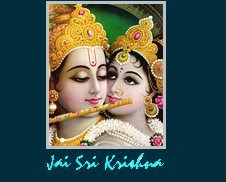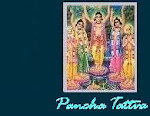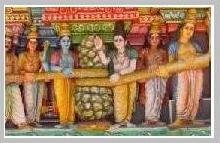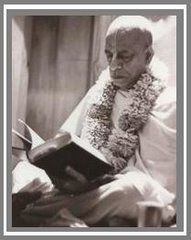A little History |
| Prior to Sri Krishna's appearance on this earth (5,000 yrs ago)there was a king named Ugrasena who ruled over Mathura. Once Ugrasena and his wife were taking a walk in the gardens when a demon saw the queen and fell in love with her. In his lust for her he diverted Ugrasena, assumed his form and the child born of this union was Kansa. Kansa grew up to dethrone his father and imprison his cousin, Devaki. While driving Devaki and her husband Vasudeva in his chariot, Kansa heard a voice in the sky telling him that he was carrying a woman whose eighth child would kill him. Kansa immediately prepared to kill Devaki. But Vasudeva intervened and begged for her life with the promise that they would hand over all their children to him soon after their birth. So Kansa imprisoned them and killed seven of their children. The land of Braj starts from Kotban near Hodel about 95 km from Delhi and ends at Runakuta which is known specially for its association with the poet Surdas, an ardent Krishna devotee . A long line of picturesque ghats - with their steps leading to the water's edge, arched gateways and temple spires extending along the right bank of the River Yamuna, emphasise the sacred character of the town of Mathura. The birth place of Lord Krishna. Mathura is today an important place of pilgrimage Before the advent of Buddha the territory that Mathura is located in was called Surasena. In Buddhist literature Mathura is called Madhura. It was also known as Mathera. Mathura was a prosperous city and the capital of a large territory. A Buddhist center was established in Mathura during the reign of the Mauryas dynasty. This center existed for a few centuries. Emperor Ashoka made many Buddha stupas in Mathura on the bank of the Yamuna. Emperor Kaniska in the first century BC and his successors constructed many Buddhist stupas and chaityas. At this time Mathura was the largest city in North India and was the capital city for the area for administration. During these times the present town of Vrindavana was just dense forests without any people living there. In the beginning of the 5th century AD the Chinese traveler Fahien saw twenty viharas (Buddhist monasteries) and three thousand Buddhist priests living in Mathura. By the middle of the 6th century AD Buddhism started to decline in the Mathura area. Many Buddhist relics have been found in the Mathura area. Many of which are found in the museums in Mathura, Calcutta and Lucknow. There is not much known about the period between 700 AD and 1018. Mahmud Ghazni invaded Mathura in 1018. He stole all the riches of the Deities, their jewels, diamonds, gold and silver. He then destroyed the temples. It took his men 20 days to plunder the city. He took 5,000 prisoners and took over 30 million rupees. He took so many statues of gold and silver and jewelry that it took over 100 camels to carry everything that he took. Tarikhi Jamina wrote a record of Mahmud Ghazni in which he described Mathura at the time that it was attacked. He wrote “If any emperors would ever dream of building temples and palaces like the one in Mathura he would have to spent thousands of golden drachmas. It is doubtful that the best sculptors and artists could build a city like this if they worked uninterruptedly for two hundred years.” According to some historian, in the temples in Mathura at this time, there were five Deities made of pure gold, each 5m (15 ft) high and the eyes of the Deities were made of diamonds, each worth not less than 5,000 golden drachmas. They were set with emeralds that were extremely brilliant and transparent. During his rule, Pherose Khan Jughalak (1351-1388) destroyed all the temples that were within the territory that he ruled. While he ruled no one was allowed to go on pilgrimage to holy places or allowed to bath in a sacred place. From the eleventh century until the end of the sixteenth century temples in Braja were periodically destroyed. Sekandar Lodi (1488-1516) first duty after conquering a place was to destroy all the temples there. He attacked Mathura in 1500. Sri Caitanya Mahaprabhu visited Vrindavana in 1514 during the rule of Sekandar Lodhi. Babar, the king of Kabul defeated Ibrahim Lodi in the battle of Panipat in 1526. He died in 1530, and his son Humayun took over the throne of Northern India. After ruling for ten years Humayun was defeated by Sher Shah in 1540 and he fled to Kabul. During his rule Sher Shah built a road between Punjab and Bengal, which had wells every two miles and pilgrim sheds along the way for Hindus and Muslims. This road helped to make it easier for pilgrims from Bengal to visit Vrindavana. In 1556 Humayun returned and defeated Sher Shah. During this time the Mughals and Pathanas were busy fighting with each other and did not have any time to bother any temple. Madana Mohana (Gopala) revealed himself to Sanatana Gosvami in 1533 and Govinda Deva revealed. Himself to Rupa Gosvami in 1535, during the rule of Humayun. Soon after returning to India, Humayun died and his son Akbar took over the throne. Akbar was a tolerant and pious emperor and he did not bother Hindus in any way. Aurangzeb, the great grandson of Akbar, had his army attack Vrindavana in 1670 and had many of the temples destroyed or desecrated. In 1757, Nadir Shah’s commander in chief, Ahmed Shah Durani, plundered Braja Mandal and killed some of the residents. In 1803, Mathura came under the British rule and from then on there was peace in the area of Mathura. |
"Athato Brahma-Jijnasa.. Now in this human form of life, inquire about the absolute truth". - Vedanta Sutra -



The demigods (suras) and demons (asuras) undertook the Churning of the milk-ocean to obtain the nectar of immortality.
Dhara Kaho He
Ruddha Habe Nai
**********************
The Divine Current
will never be Obstructed.
Ruddha Habe Nai
**********************
The Divine Current
will never be Obstructed.

A.C. Bhaktivedanta Swami
Tools
Look Here:
- www.Dharmakshetra.com
- Vedic Treasure
- Figure of beauty
- Lives of the Saints
- Ohe Vaisnava
- Birds & Plants mentioned in Vaisnava Literature
- A Garland of Prayers
- Brahmaji appears in a flash
- A humble recipe link
- Flash and Slide ..Shows
- O Sri Vrindavan
- Radha Shyamsundar's Website
- Rasikananda's Syamananda Sataka
- Saranagati by Srila Bhaktivinode
- Sri Gadadharastakam
- Sri Gopal Tapani Upanishad
- Old Pages
- Puranic Time Measurements "Explained".
- Feast for the Eyes
- Ekadasi and Caturmasya Guidelines

SRIMAD-BHAGWATAM is mula-pramana, the original root of all Vedic evidence.


............... Divine Soil ...........

Blog Archive
-
▼
2009
(148)
-
▼
January
(14)
- Annoyed by the cat
- Shooting blanks
- Our common quest
- Terrorism in Mathura
- Over and Under
- Somethings never change.
- Attempting to get out
- When your Guru Acharya thinks of YOU is he pleased ?
- Juvenile Love
- A Palatial Vimana (aircraft in the form of a palac...
- Heavenly Aircraft
- UFO - Mystic Airplane - Vimana
- World War of 3137 BC
- Prabhupad said:
-
▼
January
(14)


Gopijana ballavah..Kunjabi Hari


The Bhagavad Gita manifested 3137 BC at Kurukshetra, India


The four legs of the Holy bull ( Dharma ) represent austerity, cleanliness, mercy and truthfulness.


Prasadam (mode of goodness foodstuffs, prepared and offered to Krsna with love and devotion)

Hearing the Karatals resound, and the Mrdangas playing sweetly, everyone will feel great satisfaction

Simply by seeing, touching, remembering, praying to, bowing before, hearing about or simply by sowing this tree, there is always auspiciousness.

